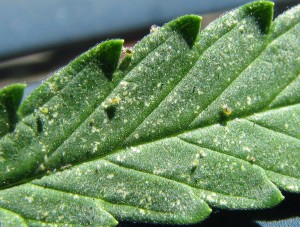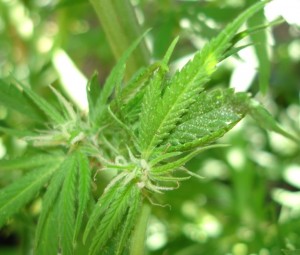Known As: Spider Mite
Scientific Name: Tetranychus urticae [Acari: Tetranychidae]
Affected Plants: Numerous plants
Spider mites on marijuana plants are a common pest that you will eventually find infesting your garden (indoors and outdoors) and they can be a very difficult pest to eliminate.
Physical Description
Spider mites on marijuana plants are quite small ( a 1/50th inch in length) and their body is separated into 2 parts:
- Mouth (or gnathosoma)
- Physical Body (or idiosoma)
The color of their bodies ranges from green- to yellow-orange color and it is easily recognized by the two (2) dark areas on the idiosoma (the physical body). If you use a magnifying glass you will see the physical body of spider mites is semi-transparent with the different coloration of their spots.
During the larval phase, spider mites have 6 legs. When they start the nymphal stage of their development, they grow an additional pair of legs (total of 8 legs = a “spider”) that the spider mites have during their adult life.
Spider Mite Life Cycle
Depending on the temperature and humidity, a spider mite can become an adult in 5 – 20 days, and one (1) adult female spider mite can lay from 20 to 200 eggs each day of its life. Female spider mites lay eggs on the bottom of the marijuana plant’s leaves that are globular, clear, and about 0.14 mm in size.
After becoming adult, spider mites live an additional 2 – 4 weeks and have many overlapping generations so they can quickly infest marijuana plants in the future.
Spider Mite Damage on Marijuana Plants
The spider mites pierce the epidermis with their sharp teeth and slim mouths. They prefer to live on the underside of leaves so you will want to look for small yellow- or bronze-colored areas to find spider mites on marijuana plants.
When the spider mite bites (punctures) through the epidermis of marijuana plants, this causes the plants to start leaking sap that serves as the mite’s source of food. The leave’s mesophyll cells are injured so within hours the punctured areas develop chlorotic spots and the marijuana plant’s ability for photosynthesis reduces.
Marijuana plants can become infested within days or even hours. Spider mites can rapidly expand their spider webs and will eventually cover the entire canopy of your marijuana plants (from top-to-bottom).
Treating Spider Mite Infestations
 The damage to marijuana plants from an uncontrolled spider mite infestation can be so bad that growers will throw away infested plants or their complete indoor garden. Small problems with spider mites during the vegetative growth period can rapidly change to a pandemic infestation when you start blooming.
The damage to marijuana plants from an uncontrolled spider mite infestation can be so bad that growers will throw away infested plants or their complete indoor garden. Small problems with spider mites during the vegetative growth period can rapidly change to a pandemic infestation when you start blooming.
By the third week of blooming marijuana plants, it becomes too late to use many of the effective and popular sprayers against spider mite infestations. The #1 concern when treating spider mites on marijuana plants is the potential pesticide residue left behind that can be hazardous to your health or ruin its good taste.
Flowering marijuana plants have higher phytotoxic reactions to sprays so if they are used in daylight it can cause more harm than benefit for your marijuana plants. If a spray has to be used to treat spider mites on flowering marijuana plants, spray during the nighttime or decrease the light intensity of your lamps.
Safe and Effective Pesticides for Spider Mites
There is a wide range of pesticide products that are available at your local hydroponics store or garden supply. Most of the products available are safe to use, but there are a few that should be avoided. Be 100% sure that the pesticide you choose is approved for use on food crops.
Just to give you an idea, here are some examples of safe sprays that are effective against spider mites:
 Safer Insecticidal Soap
Safer Insecticidal Soap
- Safer Bioneem
- And much more…
Most pesticides are called “contact killers,” so their effectiveness relies on how well you spray (or cover) the marijuana plants. But, the main problem with the safe and organic sprays is that typically they are ineffective against spider mite eggs.
You will need to maintain a spray-treatment regime that should be applied 4 – 7 days after the 1st treatment to order to eliminate spider mites that have hatched from eggs. Smaller plants can be 100% covered in a pesticide by turning them upside-down to dip in a pesticide-water solution to ensure the spider mite-infested plants are completely soaked.
Neem oil is effective and organically created by pressing the oils from neem tree seeds. The Azadirachtin (a natural chemical) found in neem oil inhibits spider mites and other pests’ ability to molt (shed their outer covering) so they are unable to enter their next phase of development.
Also, organic neem oil is systemic, which means the oil can enter into the plant’s circulatory system so it flows throughout the entire plant and continues to help prevent spider mite infestations.
Dangerous Miticides
Some very dangerous miticide sprays could easily treat spider mites on marijuana plants in as little as two spray treatments.
These sprays may be attractive due to how effective they are in dealing with mites, but they are NOT meant to be used for marijuana plants, vegetables, or any sort of food for human or animal consumption.
Commercial sprays listed below must NEVER ever be used on marijuana plants:
- Avid
- Floramite
- Shuttle
- Telstar
- TetraSan
- Hexagon
- Forbid
- Judo
- And others…
The Environmental Protection Agency (EPA) and the United States Department of Agriculture (USDA) have approved these commercial and dangerous miticides are ONLY to be used on ornamental plants.
Insecticidal and Miticidal Sprays
Avoid spraying marijuana plants with products that use the same active compounds to treat spider mites. If you use only one product or products that use the same active ingredients then there is the possibility that the spider mite population can develop immunity.
Spider mites on marijuana plants will always be in different stages of development (from an egg -> larval -> nymphal -> adult) and using one (1) insecticidal/miticidal spray is rarely effective on spider mites in all these stages of life.
Using a spray treatment might be effective to kill all of the adult and nymphal spider mites, but may not eliminate the eggs and larval so this means survivors, which is bad in two (2) ways:
1. Surviving spider mites will re-establish their colonies
2. Female spider mites that survived can pass on their immunity
The best regimen to treat spider mites on marijuana plants is a rotation using three (3) different products (with different active ingredients) and should target all stages of their development (from egg to adult).
Predator Insect Controls
 Predator insects have a symbiotic relationship with marijuana plants because spider mites are a primary food source for them. If you choose to use this type of biological control to control spider mites then be sure to use treatment sprays that will not harm or kill your predator insects.
Predator insects have a symbiotic relationship with marijuana plants because spider mites are a primary food source for them. If you choose to use this type of biological control to control spider mites then be sure to use treatment sprays that will not harm or kill your predator insects.
Beneficial and common predator insects for marijuana plants are described below:
1. Phytoseiulus persimilis
Wide Temp Assortment, Moderate Humidity
Temperature level Selection: 55 – 105+˚F
Humidity Range: 55 – 90%
2. Neoseiulus californicus
Modest Temperature Variety, High Moisture
Temperature level Range: 55 – 90˚F
Humidity Selection: 60 – 90%
3. Mesoseiulus longipes
Largest Moisture and Temperature Assortment
Temperature Array: 55 – 105+˚F
Humidity Selection: 45 – 90%
Ladybugs can also be used as predator insects to help control spider mites on marijuana plants, but Ladybugs seem to “kill themselves“ by flying into indoor lighting systems so ladybugs are better suited for greenhouses.
Cleanliness of Marijuana Plants
In addition to spraying spider mites on marijuana plants, you can take preventative steps through cleanliness and best practices for gardening.
- Occasionally clean and disinfect the walls and floor
- Do not contaminate your garden with outside clones or other plants
- Do not bring in or use contaminated growing medium or old equipment, unless it has been sterilized
- Filter air coming into your growing area as well as the exhaust going out
- Keep pets out of the growing areas
By keeping your growing area and marijuana plants clean (and keep yourself clean too – clothing, shoes, gardening tools, etc.), you are reducing the chances of spider mites and many other problems. Remember, “Cleanliness is Next to Godliness.”
Let us know what you think.






Responses